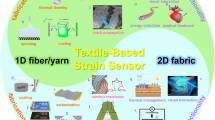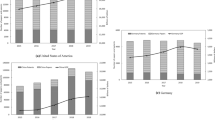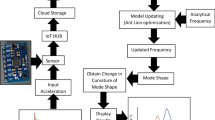Abstract
A simple sensor design to achieve different electromechanical impedance (EMI) characteristics is required for the serial/parallel multi-sensing interrogation. Aiming at the shortcomings of traditional trial-and-error method for collocating serial/parallel PZT transducer with different EMI characteristics, this paper proposes a simple but effective method to design and fabricate PZT transducers with distinguished EMI characteristics by bonding PZT patch on permanent magnet disks with different thickness. The thickness of the magnetic disk could change the impedance resonant frequency of the transducer almost linearly, which greatly simplifies the transducer design to ensure each one has distinguished peak frequency. The EMI responses of proposed smart modulation transducer (SMT) under different thickness of magnetic disk were obtained by finite element method (FEM) simulations, as well as by experiments. The simulation outcomes are in good agreement with experimental results. And it is concluded that the EMI resonant peak frequency of SMT increases linearly due to the increase of magnet thickness, which ensures each SMT has very different EMI characteristics. Both experiments and simulations have confirmed that the proposed method is effective. To obtain the insight of the performance of the SMT to structural damage detection using multi-sensing EMI method, the four fabricated SMTs with different thickness of magnetic disk were series-connected for multi-bolt loosening monitoring. Results validate that the response signatures with distinguished EMI characteristics can be obtained, and both the severity and location of bolt looseness can be identified via the modified MAPD (mean absolute percentage deviation) damage index. The proposed PZT design method has great guiding role for optimizing the design of sensors for EMI-based multi-sensing interrogation, promoting the practical application of EMI technology in metal structure health monitoring.















Similar content being viewed by others
References
Peng J, Xiao L, Zhang J, Cai CS, Wang L (2019) Flexural behavior of corroded HPS beams. Eng Struct 195:274–287. https://doi.org/10.1016/j.engstruct.2019.06.006
Huo L, Li C, Jiang T, Li HN (2018) Feasibility study of steel bar corrosion monitoring using a piezoceramic transducer enabled time reversal method. Appl Sci 8(11):2304. https://doi.org/10.3390/app8112304
Peng J, Hu S, Zhang J, Cai CS, Li LY (2019) Influence of cracks on chloride diffusivity in concrete: a five-phase mesoscale model approach. Constr Build Mater 197:587–596. https://doi.org/10.1016/j.conbuildmat.2018.11.208
Li N, Wang F, Song G (2020) New entropy-based vibro-acoustic modulation method for metal fatigue crack detection: an exploratory study. Measurement 150:107075. https://doi.org/10.1016/j.measurement.2019.107075
Sawicki B, Brühwiler E (2020) Long-term strain measurements of traffic and temperature effects on an RC bridge deck slab strengthened with an R-UHPFRC layer. J Civil Struct Health Monit 10(2):333–344. https://doi.org/10.1007/s13349-020-00387-3
Zhu J, Ho SCM, Kong Q, Patil D, Mo YL, Song G (2017) Estimation of impact location on concrete column. Smart Mater Struct 26(5):055037. https://doi.org/10.1088/1361-665X/aa6768
Ji Q, Ho M, Zheng R, Ding Z, Song G (2015) An exploratory study of stress wave communication in concrete structures. Smart Struct Syst 15(1):135–150. https://doi.org/10.12989/sss.2015.15.1.135
Siu S, Ji Q, Wu W, Song G, Ding Z (2014) Stress wave communication in concrete: I. Characterization of a smart aggregate based concrete channel. Smart Mat Struct 23(12):125030. https://doi.org/10.1088/0964-1726/23/12/125030
Kong Q, Robert RH, Silva P, Mo YL (2016) Cyclic crack monitoring of a reinforced concrete column under simulated pseudo-dynamic loading using piezoceramic-based smart aggregates. Appl Sci 6(11):341. https://doi.org/10.3390/app6110341
Lu G, Wang T, Zhou M, Li Y (2019) Characterization of ultrasonic energy diffusion in a steel alloy sample with tensile force using PZT transducers. Sensors 19(9):2185. https://doi.org/10.3390/s19092185
Wang G (2013) Analysis of bimorph piezoelectric beam energy harvesters using Timoshenko and Euler–Bernoulli beam theory. J Intell Mater Syst Struct 24(2):226–239. https://doi.org/10.1177/1045389X12461080
Ewere F, Wang G (2014) Performance of galloping piezoelectric energy harvesters. J Intell Mater Syst Struct 25(14):1693–1704. https://doi.org/10.1177/1045389X13505251
Ma Y, Ji Q, Chen S, Song G (2017) An experimental study of ultra-low power wireless sensor-based autonomous energy harvesting system. J Renew Sustain Energy 9(5):054702. https://doi.org/10.1063/1.4997274
Huo L, Chen D, Kong Q, Li H, Song G (2017) Smart washer—a piezoceramic-based transducer to monitor looseness of bolted connection. Smart Mater Struct 26(2):025033. https://doi.org/10.1088/1361-665X/26/2/025033
Jiang T, Wu Q, Wang L, Huo L, Song G (2018) Monitoring of bolt looseness-induced damage in steel truss arch structure using piezoceramic transducers. IEEE Sens J 18(16):6677–6685. https://doi.org/10.1109/JSEN.2018.2847308
Hei C, Luo M, Gong P, Song G (2020) Quantitative evaluation of bolt connection using a single piezoceramic transducer and ultrasonic coda wave energy with the consideration of the piezoceramic aging effect. Smart Mater Struct 29(2):027001. https://doi.org/10.1088/1361-665X/ab6076
Chen B, Hei C, Luo M, Ho MSC, Song G (2018) Pipeline two-dimensional impact location determination using time of arrival with instant phase (TOAIP) with piezoceramic transducer array. Smart Mater Struct 27(10):105003. https://doi.org/10.1088/1361-665X/aadaa9
Raju J, Bhalla S, Visalakshi T (2020) Pipeline corrosion assessment using piezo-sensors in reusable non-bonded configuration. NDT E Int 111:102220. https://doi.org/10.1016/j.ndteint.2020.102220
Li W, Kong Q, Ho SCM, Lim I, Mo YL, Song G (2016) Feasibility study of using smart aggregates as embedded acoustic emission sensors for health monitoring of concrete structures. Smart Mater Struct 25(11):115031. https://doi.org/10.1088/0964-1726/25/11/115031
Zou D, Du C, Liu T, Li W (2019) Effects of temperature on the performance of the piezoelectric-based smart aggregates active monitoring method for concrete structures. Smart Mater Struct 28(3):035016. https://doi.org/10.1088/1361-665X/aafe15
Xu K, Ren C, Deng Q, Jin Q, Chen X (2018) Real-time monitoring of bond slip between GFRP bar and concrete structure using piezoceramic transducer-enabled active sensing. Sensors 18(8):2653. https://doi.org/10.3390/s18082653
Li X, Luo M, Hei C, Song G (2019) Quantitative evaluation of debond in concrete-filled steel tubular member (CFSTM) using piezoceramic transducers and ultrasonic head wave amplitude. Smart Mater Struct 28(7):075033. https://doi.org/10.1088/1361-665X/ab1f27
Wang T, Song G, Wang Z, Li Y (2013) Proof-of-concept study of monitoring bolt connection status using a piezoelectric based active sensing method. Smart Mater Struct 22(8):087001. https://doi.org/10.1088/0964-1726/22/8/087001
Liang C, Sun FP, Rogers CA (1997) Coupled electromechanical analysis of adaptive material system—determination of actuator power consumption and system energy transfer. J Intell Mater Syst Struct 8(4):335–343. https://doi.org/10.1177/1045389X9700800406
Wang F, Ho SCM, Huo L, Song G (2018) A novel fractal contact-electromechanical impedance model for quantitative monitoring of bolted joint looseness. IEEE Access 6:40212–40220. https://doi.org/10.1109/ACCESS.2018.2855693
Wang T, Liu S, Shao J, Li Y (2016) Health monitoring of bolted joints using the time reversal method and piezoelectric transducers. Smart Mater Struct 25(2):025010. https://doi.org/10.1088/0964-1726/25/2/025010
Wang F, Song G (2019) Bolt early looseness monitoring using modified vibro-acoustic modulation by time-reversal. Mech Syst Signal Process 130:349–360. https://doi.org/10.1016/j.ymssp.2019.04.036
Wang F, Chen Z, Song G (2020) Monitoring of multi-bolt connection looseness using entropy-based active sensing and genetic algorithm-based least square support vector machine. Mech Syst Signal Process 136:106507. https://doi.org/10.1016/j.ymssp.2019.106507
Park G, Cudney HH, Inman DJ (2000) Impedance-based health monitoring of civil structural components. J Infrastruct Syst 6(4):153–160. https://doi.org/10.1061/(ASCE)1076-0342(2000)6:4(153)
Providakis CP, Liarakos EV, Kampianakis E (2013) Nondestructive wireless monitoring of early-age concrete strength gain using an innovative electromechanical impedance sensing system. Smart Mat Res 2013:932568. https://doi.org/10.1155/2013/932568
Park G, Cudney HH, Inman DJ (2001) Feasibility of using impedance-based damage assessment for pipeline structures. Earthquake Eng Struct Dynam 30(10):1463–1474. https://doi.org/10.1002/eqe.72
Huo L, Chen D, Liang Y, Li H, Feng X, Song G (2017) Impedance based bolt pre-load monitoring using piezoceramic smart washer. Smart Mater Struct 26(5):057004. https://doi.org/10.1088/1361-665X/aa6a8e
Shao J, Wang T, Yin H, Yang D, Li Y (2016) Bolt looseness detection based on piezoelectric impedance frequency shift. Appl Sci 6(10):298. https://doi.org/10.3390/app6100298
Xu J, Dong J, Li H, Zhang C, Ho SC (2019) Looseness monitoring of bolted spherical joint connection using electro-mechanical impedance technique and BP neural networks. Sensors 19(8):1906. https://doi.org/10.3390/s19081906
Giurgiutiu V, Reynolds A, Rogers CA (1999) Experimental investigation of E/M impedance health monitoring for spot-welded structural joints. J Intell Mater Syst Struct 10(10):802–812. https://doi.org/10.1106/N0J5-6UJ2-WlGV-Q8MC
Zhang J, Zhang C, Xiao J, Jiang J (2019) A PZT-based electromechanical impedance method for monitoring the soil freeze–thaw process. Sensors 19(5):1107. https://doi.org/10.3390/s19051107
Wu J, Li W, Feng Q (2018) Electro-mechanical impedance (EMI) based interlayer slide detection using piezoceramic smart aggregates—a feasibility study. Sensors 18(10):3524. https://doi.org/10.3390/s18103524
Shi Y, Luo M, Li W, Song G (2018) Grout compactness monitoring of concrete-filled fiber-reinforced polymer tube using electromechanical impedance. Smart Mater Struct 27(5):055008. https://doi.org/10.1088/1361-665X/aabaaf
Li W, Liu T, Zou D, Wang J, Yi TH (2019) PZT based smart corrosion coupon using electromechanical impedance. Mech Syst Signal Process 129:455–469. https://doi.org/10.1016/j.ymssp.2019.04.049
Zagrai AN, Giurgiutiu V (2001) Electro-mechanical impedance method for crack detection in thin plates. J Intell Mater Syst Struct 12(10):709–718. https://doi.org/10.1177/104538901320560355
Lim YY, Soh CK (2014) Electro-mechanical impedance (EMI)-based incipient crack monitoring and critical crack identification of beam structures. Res Nondestr Eval 25(2):82–98. https://doi.org/10.1080/09349847.2013.848311
Zuo C, Feng X, Zhang Y, Lu L, Zhou J (2017) Crack detection in pipelines using multiple electromechanical impedance sensors. Smart Mater Struct 26(10):104004. https://doi.org/10.1088/1361-665X/aa7ef3
Xu YG, Liu GR (2002) A modified electro-mechanical impedance model of piezoelectric actuator-sensors for debonding detection of composite patches. J Intell Mater Syst Struct 13(6):389–396. https://doi.org/10.1177/104538902761696733
Giurgiutiu V, Harries K, Petrou M, Bost J, Quattlebaum JB (2003) Disbond detection with piezoelectric wafer active sensors in RC structures strengthened with FRP composite overlays. Earthq Eng Vib 2(2):213–223. https://doi.org/10.1007/s11803-003-0005-9
Li W, Fan S, Ho SCM, Wu J, Song G (2018) Interfacial debonding detection in fiber-reinforced polymer rebar–reinforced concrete using electro-mechanical impedance technique. Struct Health Monit 17(3):461–471. https://doi.org/10.1177/1475921717703053
Wang T, Wei D, Shao J, Li Y, Song G (2018) Structural stress monitoring based on piezoelectric impedance frequency shift. J Aerospace Eng 31(6):04018092. https://doi.org/10.1061/(ASCE)AS.1943-5525.0000900
Kocherla A, Subramaniam KV (2020) Embedded electrical impedance-based PZT sensor for monitoring hydrating concrete: development and evaluation. Smart Mater Struct 29(5):055038. https://doi.org/10.1088/1361-665X/ab6955
Moharana S, Bhalla S (2019) Development and evaluation of an external reusable piezo-based concrete hydration-monitoring sensor. J Intell Mater Syst Struct 30(18–19):2770–2788. https://doi.org/10.1177/1045389X19873414
Giurgiutiu V, Rogers CA (1999) Modeling of the electro-mechanical (E/M) impedance response of a damaged composite beam. In: Proceedings of the ASME winter annual meeting, ASME aerospace and materials divisions, adaptive structures and material systems symposium, vol. 59, Nashville, TN, 14–19 November, ASME, New York, pp. 39–46
Park G, Inman DJ (2007) Structural health monitoring using piezoelectric impedance measurements. Philos Trans R Soc A Math Phys Eng Sci 365(1851):373–392. https://doi.org/10.1098/rsta.2006.1934
Wang D, Zhu H (2011) Monitoring of the strength gain of concrete using embedded PZT impedance transducer. Constr Build Mater 25(9):3703–3708. https://doi.org/10.1016/j.conbuildmat.2011.04.020
Tseng KK, Naidu AS (2002) Non-parametric damage detection and characterization using smart piezoceramic material. Smart Mater Struct 11(3):317. https://doi.org/10.1088/0964-1726/11/3/301
Wang D, Song H, Zhu H (2013) Numerical and experimental studies on damage detection of a concrete beam based on PZT admittances and correlation coefficient. Constr Build Mater 49:564–574. https://doi.org/10.1016/j.conbuildmat.2013.08.074
Ai D, Zhu H, Luo H, Yang J (2014) An effective electromechanical impedance technique for steel structural health monitoring. Constr Build Mater 73:97–104. https://doi.org/10.1016/j.conbuildmat.2014.09.029
Tinoco HA, Marulanda DJ (2014) A new index for damage identification in active beams with electromechanical impedance technique approach to SHM. In Proceedings of the 2nd International Conference on Advanced Mechatronics, Design, and Manufacturing Technology (AMDM 2014), Bogota, Colombia, 22–24 October 2014, pp. 1–6
Zhou P, Wang D, Zhu H (2018) A novel damage indicator based on the electromechanical impedance principle for structural damage identification. Sensors 18(7):2199. https://doi.org/10.3390/s18072199
Yang Y, Lim YY, Soh CK (2008) Practical issues related to the application of the electromechanical impedance technique in the structural health monitoring of civil structures: II. Numerical verification. Smart Mat Struct 17(3):035009. https://doi.org/10.1088/0964-1726/17/3/035008
Park S, Ahmad S, Yun CB, Roh Y (2006) Multiple crack detection of concrete structures using impedance-based structural health monitoring techniques. Exp Mech 46(5):609–618. https://doi.org/10.1007/s11340-006-8734-0
Li W, Wang J, Liu T, Luo M (2020) Electromechanical impedance instrumented circular piezoelectric-metal transducer for corrosion monitoring modeling and validation. Smart Mater Struct 29(3):035008. https://doi.org/10.1088/1361-665X/ab675c
Liang Y, Li D, Parvasi SM, Kong Q, Lim I, Song G (2016) Bond-slip detection of concrete-encased composite structure using electro-mechanical impedance technique. Smart Mater Struct 25(9):095003. https://doi.org/10.1088/0964-1726/25/9/095003
Li L, Xia Y, Chen G (2018) Experimental and numerical studies of debonding monitoring of FRP shear-strengthened beams using EMI technique. J Aerospace Eng 31(5):04018048. https://doi.org/10.1061/(ASCE)AS.1943-5525.0000876
Fan S, Li W, Kong Q, Feng Q, Song G (2018) Monitoring of pin connection loosening using eletromechanical impedance numerical simulation with experimental verification. J Intell Mater Syst Struct 29(9):1964–1973. https://doi.org/10.1177/1045389X18754354
Guo B, Chen D, Huo L, Song G (2020) Monitoring of grouting compactness in tendon duct using multi-sensing electro-mechanical impedance method. Appl Sci 10(6):2018. https://doi.org/10.3390/app10062018
Na WS, Baek J (2018) A review of the piezoelectric electromechanical impedance based structural health monitoring technique for engineering structures. Sensors 18(5):1307. https://doi.org/10.3390/s18051307
Hey F, Bhalla S, Soh CK (2006) Optimized parallel interrogation and protection of piezo-transducers in electromechanical impedance technique. J Intell Mater Syst Struct 17(6):457–468. https://doi.org/10.1177/1045389X06058792
Na S, Lee HK (2013) A multi-sensing electromechanical impedance method for non-destructive evaluation of metallic structures. Smart Mater Struct 22(9):095011. https://doi.org/10.1088/0964-1726/22/9/095011
Priya CB, Saravanan TJ, Balamonica K, Gopalakrishnan N, Rao ARM (2018) EMI based monitoring of early-age characteristics of concrete and comparison of serial/parallel multi-sensing technique. Constr Build Mater 191:1268–1284. https://doi.org/10.1016/j.conbuildmat.2018.10.079
Balamonica K, Saravanan TJ, Priya CB, Gopalakrishnan N (2019) Piezoelectric sensor–based damage progression in concrete through serial/parallel multi-sensing technique. Struct Health Monit 19(2):339–356. https://doi.org/10.1177/1475921719845153
Chen D, Huo L, Song G (2020) EMI based multi-bolt looseness detection using series/parallel multi-sensing technique. Smart Struct Syst 25(4):423–432. https://doi.org/10.12989/sss.2020.25.4.423
Kim J, Grisso BL, Kim JK, Ha DS, Inman DJ (2008) Electrical modeling of piezoelectric ceramics for analysis and evaluation of sensory systems. In: Proceedings of the IEEE Sensors Applications Symposium, Atlanta, GA, 12–14 February 2008, pp. 122–127. IEEE, New York, USA. https://doi.org/10.1109/SAS13374.2008.4472956
Na S, Tawie R, Lee HK (2012) Electromechanical impedance method of fiber-reinforced plastic adhesive joints in corrosive environment using a reusable piezoelectric device. J Intell Mater Syst Struct 23(7):737–747. https://doi.org/10.1177/1045389X12440754
Mascarenas DL, Todd MD, Park G, Farrar CR (2007) Development of an impedance-based wireless sensor node for structural health monitoring. Smart Mater Struct 16(6):2137. https://doi.org/10.1088/0964-1726/16/6/016
Acknowledgements
The authors thank the anonymous reviewers for their constructive suggestions, which helped improve the article. This work was supported by National Natural Science Foundation of China (No. 51978079, No. 41904124), National Key R&D project (2016YFC0303703), National Major Science and Technology Special Projects (No. 2017ZX05019001), Hubei Provincial Natural Science Foundation of China (No. 2019CFB233).
Author information
Authors and Affiliations
Corresponding author
Additional information
Publisher's Note
Springer Nature remains neutral with regard to jurisdictional claims in published maps and institutional affiliations.
Rights and permissions
About this article
Cite this article
Luo, Z., Deng, H., Li, L. et al. A simple PZT transducer design for electromechanical impedance (EMI)-based multi-sensing interrogation. J Civil Struct Health Monit 11, 235–249 (2021). https://doi.org/10.1007/s13349-020-00449-6
Received:
Revised:
Accepted:
Published:
Issue Date:
DOI: https://doi.org/10.1007/s13349-020-00449-6




